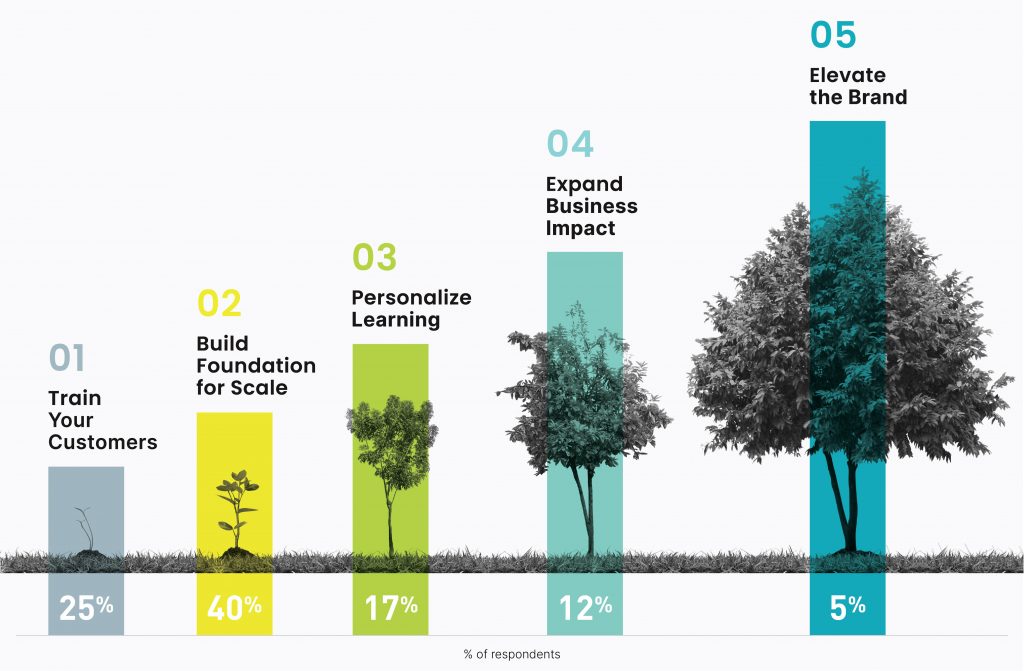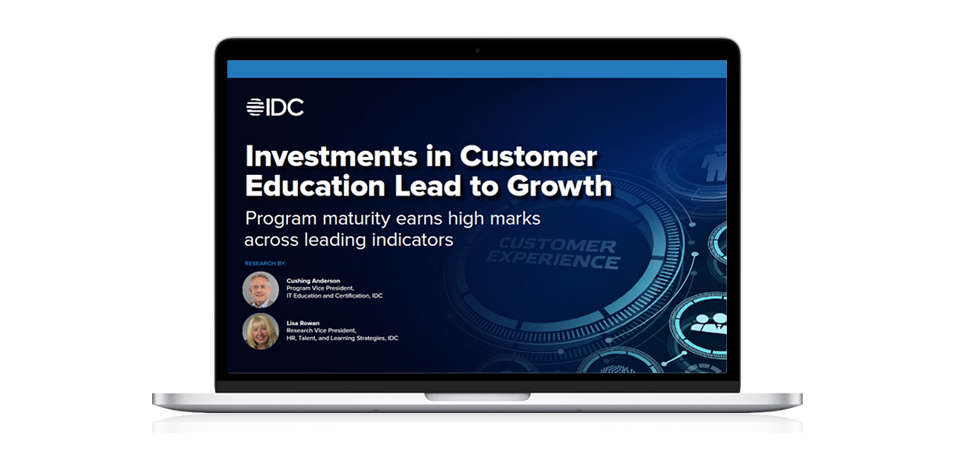New Survey Data: The State of Customer Education 2022
As products become more complex, competition increases, and customer expectations grow, there’s no better time than now to invest in customer education.
For our 4th annual State of Customer Education survey, we partnered with premier global market intelligence firm IDC to produce this InfoBrief illuminating the impact of customer and extended enterprise education across the buyer journey. In previous years, we conducted our State of Customer Education survey research in-house, focusing primarily on our own customer base. But this year, we sought out a broader, deeper, and more unbiased look at the industry.
IDC surveyed over 260 customer education teams in sectors spanning across software, telecommunications, manufacturing, and more to produce a comprehensive analysis of customer education, as well as validate business impact across our Maturity Model for Customer Learning.
And what story does the data tell?
- First, that investments in customer education lead to profound results across the customer lifecycle (the various stages a consumer goes through before, during and after they complete a purchase).
- The Customer Learning Maturity Model, a research-based roadmap of customer education programs as they grow and expand their business impact, is tightly correlated to the highest results we found. As programs reach higher maturity stages, the benefits on business performance results increase dramatically.
Whether your customer education team is in very early maturity stages, or actively working on large-scale education initiatives, read on for more insights into the state of customer education in 2022 – or download the full report here.
Key Trends for Customer Education in 2022
More Investment, Bigger Returns
One trend we’ve kept a close eye on over the last 4 years has been the amount of investment placed on customer education; Is this a growing priority for businesses? Are education programs getting more of a seat at the table in company-wide strategic planning? Are more businesses devoting one or more FTEs solely to customer education?
The answer is a resounding “yes.”
94% of surveyed companies have either increased or maintained their 2021 budget for customer education in 2022. And, while customer education brought an average revenue increase of 12% in 2021, IDC is expecting a much higher (19%) increase this year, primarily due to the rising perception of the value of customer education.
Education Delivers Outsized Returns in Manufacturing
Where we typically see software companies embracing customer education to help balance the growing complexity of their products, the survey also indicates a broadening of education in the manufacturing industry. IDC found that manufacturing firms delivered an average 24 point performance improvement based on customer education, in comparison with a 21% and 22% average improvement across Software and Technology, respectively.
Education’s Impact Across the Customer Lifecycle
While many customer education programs may start their journey focused solely on improving product adoption or onboarding, IDC found that education actually contributes directly to performance improvements of an average of 15% across all customer lifecycle measures from 2020 to 2022.
That means customer education doesn’t just affect one stage of a customer’s touchpoint with your organization – rather, it has the potential to boost everything from brand awareness to purchase decisions to brand champions and advocates.
The true value and ROI of customer education is no longer centered around onboarding, or even revenue generated from monetized education. In fact, we found a 19% increase in customer lifetime value from 2020 to 2022 attributed to customer education.
Overall Maturity Drives Education’s Impact
Applying Survey Results to the Customer Learning Maturity Model
Leveraging our own customer education maturity research, IDC categorized all survey respondents into one of five levels of maturity based on their key characteristics. The Thought Industries Customer Learning Maturity Model was derived from a separate study on over 50 organizations – we wanted to understand what the most sophisticated education programs were doing, and what were the major stages they went through to achieve their results.

Higher Maturity Indicates Higher ROI
“We’ve created this model that helps you follow in the footsteps of the most high performing customer education programs out there,” says Paul Merrylees, Senior Director of Learning Strategies at Thought Industries. “And, what IDC found was that organizations that had achieved the stage 4 and stage 5 in the model were actually delivering dramatically higher performance gains than those in the early stages.”
According to the study, compared with organization in lower maturity, the most mature customer and enterprise education organizations are seeing results such as:
- 263% increase in brand champions or advocates,
- 236% improvement in CSAT scores,
- 178% increase in demand generation,
- 138% increase in brand awareness,
- And much, much more.
While these dramatic results apply to highly mature programs, for most, there’s still plenty of room to grow and progress – and keep driving these invaluable metrics forward.
“This really lines up with the experience we have when working with programs to deploy the right technology foundation and implement the right strategies to be able to achieve a higher maturity and scale their impact,” says Merrylees. “Few have fully realized this achievement, but those that have are seeing a competitive advantage from their customer education program itself that’s very significant to the organization.”
Customer Education Beyond 2022
One thing is clear in this report on the State of Customer Education in 2022: The bar for customer education programs has gotten higher. Whereas even a few years ago, we saw new programs building their first training courses and online academies, today, we see broad investment in the sophistication and maturity of these programs in pursuit of meaningful business returns.
IDC found that this year and beyond, nearly a third of survey respondents are focused on growing and enhancing the education experience:
- 32% indicated they’re building a highly-skilled team with improved instructional design.
- 31% are developing more advanced content.
- 28% are focused on engineering more engaging learner experiences.
According to Merrylees, “Looking at 2022 and beyond, it’s about investing in the overall learner experience, serving more kinds of learners, and catering to more social learning and engagement. When we look at the report, we’re seeing an increased focus on taking the education program well beyond a table stakes level.”
See How Your Customer Education Program Stacks Up to Your Competitors
Interested in how to level up your program maturity after reading these report highlights? Learn more about the 5 stages of maturity, and explore strategies and best practices from our research in our Thought Industries Customer Learning Maturity Model.



